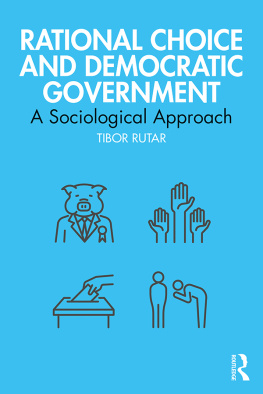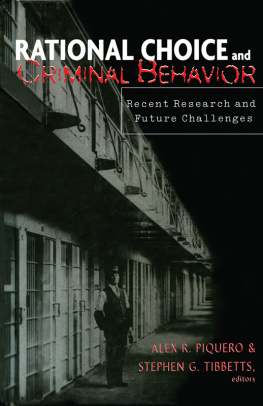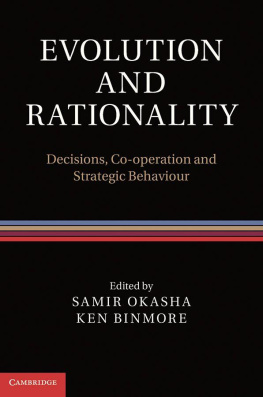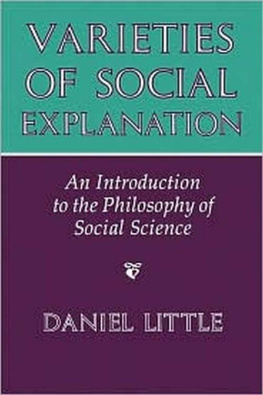Gilboa - Rational Choice
Here you can read online Gilboa - Rational Choice full text of the book (entire story) in english for free. Download pdf and epub, get meaning, cover and reviews about this ebook. City: London, year: 2012, publisher: MIT Press, genre: Romance novel. Description of the work, (preface) as well as reviews are available. Best literature library LitArk.com created for fans of good reading and offers a wide selection of genres:
Romance novel
Science fiction
Adventure
Detective
Science
History
Home and family
Prose
Art
Politics
Computer
Non-fiction
Religion
Business
Children
Humor
Choose a favorite category and find really read worthwhile books. Enjoy immersion in the world of imagination, feel the emotions of the characters or learn something new for yourself, make an fascinating discovery.
- Book:Rational Choice
- Author:
- Publisher:MIT Press
- Genre:
- Year:2012
- City:London
- Rating:4 / 5
- Favourites:Add to favourites
- Your mark:
- 80
- 1
- 2
- 3
- 4
- 5
Rational Choice: summary, description and annotation
We offer to read an annotation, description, summary or preface (depends on what the author of the book "Rational Choice" wrote himself). If you haven't found the necessary information about the book — write in the comments, we will try to find it.
A nontechnical, concise, and rigorous introduction to the rational choice paradigm, focusing on basic insights applicable in fields ranging from economics to philosophy.
Rational Choice — read online for free the complete book (whole text) full work
Below is the text of the book, divided by pages. System saving the place of the last page read, allows you to conveniently read the book "Rational Choice" online for free, without having to search again every time where you left off. Put a bookmark, and you can go to the page where you finished reading at any time.
Font size:
Interval:
Bookmark:
Rational Choice
Rational Choice
Itzhak Gilboa
The MIT Press
Cambridge, Massachusetts
London, England
2010 Massachusetts Institute of Technology
All rights reserved. No part of this book may be reproduced in any form by any electronic or mechanical means (including photocopying, recording, or information storage and retrieval) without permission in writing from the publisher.
For information about special quantity discounts, please email .
This book was set in Palatino on 3B2 by Asco Typesetters, Hong Kong.
Printed and bound in the United States of America.
Library of Congress Cataloging-in-Publication Data
Gilboa, Itzhak.
Rational choice / Itzhak Gilboa.
p. cm.
Includes bibliographical references and index.
ISBN 978-0-262-01400-7 (hardcover : alk. paper)
ISBN 978-0-262-26569-0 (e-book)
1. Rational choice theory. 2. Social choice. 3. Decision making. 4. Game theory.
5. Microeconomics. I. Title.
HM495.G55 2010
302.13dc22
2009037119
10 9 8 7 6 5 4 3
To my mother, and to the memory of my father
Contents of Online Appendixes
Available at http://mitpress.mit.edu/rationalchoice.
A Mathematical Preliminaries
A.1 Notation
A.2 Sets
A.3 Relations and Functions
A.4 Cardinalities of Sets
A.5 Calculus
A.5.1 Limits of Sequences
A.5.2 Limits of Functions
A.5.3 Continuity
A.5.4 Derivatives
A.5.5 Partial Derivatives
A.6 Topology
A.7 Probability
A.7.1 Basic Concepts
A.7.2 Random Variables
A.7.3 Conditional Probabilities
A.7.4 Independence and i.i.d. Random Variables
A.7.5 Law(s) of Large Numbers
B Formal Models
B.1 Utility Maximization
B.1.1 Definitions
B.1.2 Axioms
B.1.3 Result
B.1.4 Generalization to a Continuous Space
B.2 Convexity
B.2.1 Convex Sets
B.2.2 Convex and Concave Functions
B.2.3 Quasi-convex and Quasi-concave Functions
B.3 Constrained Optimization
B.3.1 Convex Problems
B.3.2 Example: The Consumer Problem
B.3.3 Algebraic Approach
B.3.4 Geometric Approach
B.3.5 Economic Approach
B.3.6 Comments
B.4 vNMs Theorem
B.4.1 Setup
B.4.2 The vNM Axioms
B.4.3 Continuity
B.4.4 Independence
B.4.5 The Theorem
B.5 Ignoring Base Probabilities
B.6 Arrows Impossibility Theorem
B.7 Nash Equilibrium
C Exercises
D Solutions
The purpose of this book is to introduce readers to some of the fundamental insights of rational choice theory, drawing upon the formal theories of microeconomics, decision, games, and social choice as well as upon ideas developed in philosophy, psychology, and sociology.
I believe that economic theory and its fellow disciplines have provided a remarkable collection of powerful models and general insights, which change the way we think about everyday life. At the same time, economics has been justifiably criticized on several grounds. First, economics is a mathematically oriented field that in many situations fails to provide accurate numerical predictions as do the exact sciences. Second, the basic assumptions of economics have come under attack and have been shown to be falsifiable in experimental studies. Finally, economics is often criticized for failing to deal with important and deep issues such as happiness and well-being, justice and fairness. Moreover, the scientific or pseudo-scientific approach to economics has been argued to be serving the rhetoric of capitalism in a way that may be detrimental to well-being and to justice.
The focus of this book is on some basic insights that survive these critiques. Models of rational choice have been proved sufficiently flexible to incorporate many of the phenomena that economic theory, narrowly understood, fails to explain. These models have also provided important insights into related fields such as political science, biology, and computer science. Touching upon some of philosophys oldest problems, and benefiting from the use of mathematical tools, the rational choice paradigm appears to be fundamental for understanding the behavior of people and societies, economies and nations, organisms and species. Similarly, it is indispensable for the optimal design of social institutions as well as of automated systems. Accordingly, this book emphasizes the paradigm of rational choice, the general way of thought, the conceptualization, the organizing principles, rather than a particular theory.
Observing the debate about economics and its degree of success as a science, and about the role that economists do and should play in society, one may find biases on both sides. Economists, for the most part, tend to put too little emphasis on rhetoric and the power of the implicit. Most teachers of economics will not say anything wrong about concepts such as utility maximization or Pareto optimality. Yet, they are often unaware of what their students might be reading between the lines, and they are sometimes perceived to endorse what they believe they are only describing. On the other hand, critics of economics often do not retain a sufficiently clear distinction between theory and paradigm. They sometimes flaunt failures of the theory and dismiss the entire field without paying sufficient attention to the merits of the paradigm. I hope this book will make readers aware of both types of biases.
I do not claim to provide a comprehensive list of ideas and insights that may enrich our thinking. The book touches upon issues that appear to me fundamental, useful, and relevant to most readers. I think that everyone should know whats included in this book, and I personally would prefer to live in a society in which every voter understands the issues discussed here. To an extent, this has also been my criterion for inclusion of topics; issues that are too specific or that can be relegated to experts are not included here. Needless to say, even with this criterion in mind, the selection of topics is inevitably subjective.
The book describes material that has been developed in mathematical economics. Most of this material appears in undergraduate textbooks with explicit mathematical models and in graduate textbooks and research papers with considerable mathematical depth. The goal of this book, however, is to distill the main insights and explain them in a language that would be understood by any high school graduate. I attempted to minimize the use of mathematical formulas and professional jargon. If certain paragraphs remain too technical, I hope they can be skipped with no major loss in understanding.
The book has four appendices that may help interested readers understand the issues more deeply but that are not essential for the main insights. They are available online on the books Web site, http://mitpress.mit.edu/rationalchoice. Appendix A provides a brief introduction to the mathematical concepts used in the other appendices. Appendix B contains a rigorous exposition of some of the material discussed in the book. Appendix C consists of exercises, whose solutions are provided in Appendix D. If the text is covered with these appendices, the book may serve as a textbook for an undergraduate course.
I am grateful to many teachers, colleagues, and students for conversations and comments that have taught and enriched me in many ways. The motivation for writing this book arose from discussions with Herv Crs and Eddie Dekel. Earlier versions of this book benefited greatly from comments by Daron Acemoglu, Alessandro Citanna, Eva Gilboa-Schechtman, Brian Hill, Barry ONeill, Andrew Ortony, Marion Oury, and Tristan Tomala as well as from reviewers and editors. I am very grateful also for the bibliographic help and comments of Nira Liberman, Doron Ravid, Arik Roginsky, and Dov Shmotkin.
Next pageFont size:
Interval:
Bookmark:
Similar books «Rational Choice»
Look at similar books to Rational Choice. We have selected literature similar in name and meaning in the hope of providing readers with more options to find new, interesting, not yet read works.
Discussion, reviews of the book Rational Choice and just readers' own opinions. Leave your comments, write what you think about the work, its meaning or the main characters. Specify what exactly you liked and what you didn't like, and why you think so.







